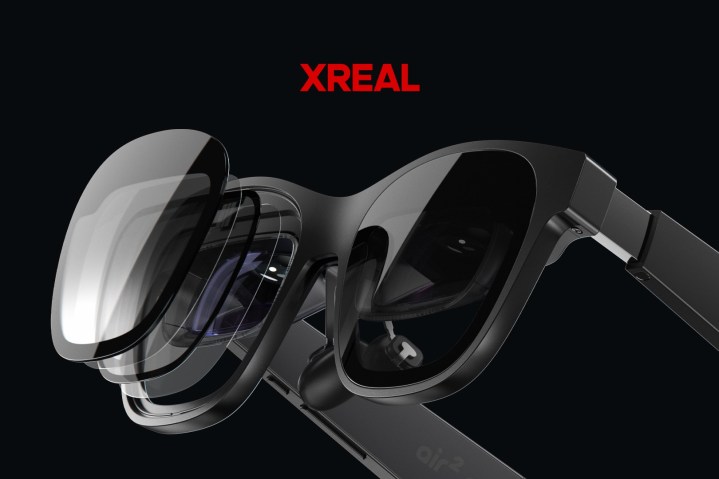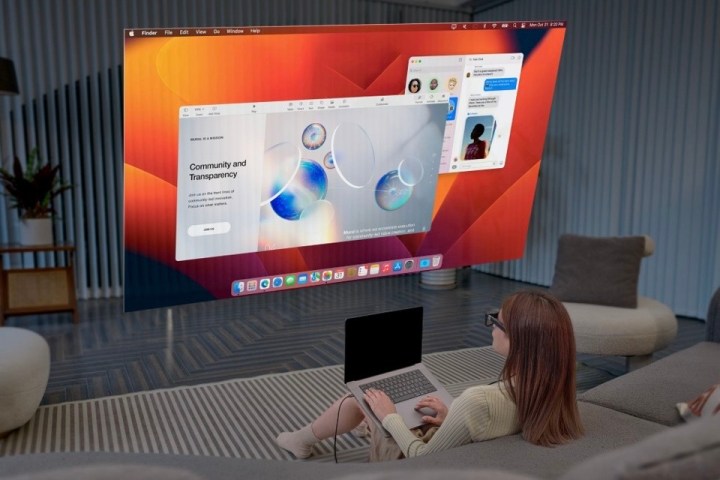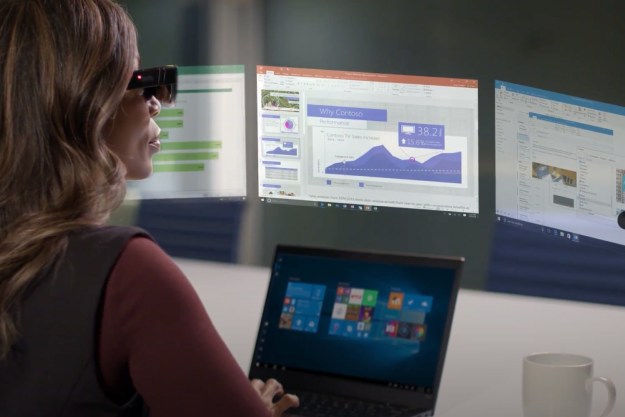
Xreal (formerly Nreal) just announced the second generation of its popular smart glasses, the Xreal Air 2. The new model is even lighter and features brighter displays with higher density. The Xreal Air 2 is compatible with a wide variety of laptops, computers, phones, and gaming devices, providing a large virtual screen in a compact and easy-to-carry pair of glasses.
Like many similar smart glasses, the Xreal Air 2 are meant to replicate virtual screens right in your glasses without the need for multiple monitors.
Compared to the Xreal Air, the Air 2’s displays are 25% brighter, with better color fidelity. They should also be more comfortable and look more like normal glasses since Xreal managed to reduce the weight and thickness with the new design.

The detachable shades that dim ambient light look like regular sunglasses. A new Air 2 Pro model has adjustable electrochromic shades with three background dimming positions, including 99.9% black. There are black and red color options, plus Xreal’s Kaleido Kit offers a choice of six colorful skins to customize the appearance of your Air 2 smart glasses.
At just 72 grams (2.5oz), the Air 2 is 10% lighter than the original model. That might not seem like a big difference, but that weight rests mostly on your nose, with some on your ears, so every little bit helps. The earpieces now flex, which means they should fit more comfortably on various head shapes and sizes. Softer nose pads help relieve any pressure on your nose.
As a monitor and TV replacement, the Xreal Air 2’s screens need to be bright. They supply up to 500 nits of brightness, 25% more than the original Air glasses, while meeting TÜV Rheinland standards for limiting blue light and flickering to protect eye health. The refresh rate can go as high as 120Hz.

Using the latest Sony micro-OLED technology, color exceeds the SRGB color gamut with a display industry standard gamma of 2.2. The Xreal Air 2’s improved displays should look more like a large HD monitor, with proper contrast and color saturation.
Xreal says the view is equivalent to a 330-inch screen at six meters. That’s a subjective measurement, of course, since you might perceive the virtual screen as closer than someone else. A more accurate metric is the 46-degree field of view. A large HD screen fills your central view when plugged into a device that supports USB-C Alt mode.
Audio is reportedly enhanced to reduce sound leakage and improve spatial separation. Movies should sound better and become more immersive.
You can turn your head to see up to three virtual monitors near your laptop.
Like the Nreal Air, the Xreal Air 2 smart glasses work with Nebula, a virtual AR desktop app for the Mac and PC. With Nebula, you can turn your head to see up to three virtual monitors near your laptop. There’s also a Nebula app for Android phones, but it presents an ultrawide display that appears as you turn to either side.
Most of the smart glasses I’ve tested lack spatial awareness, so the virtual screen locks to the center of your view no matter where you look. That isn’t always bad, but it’s nice to have the option to turn away and interact with others.
In July, Xreal launched an accessory called Beam that makes its Air smart glasses compatible with a wider variety of devices and anchors one virtual screen in place. The Xreal Air 2 works with Beam and other adapters, so you can connect to most computers, phones, and handheld gaming consoles.
The Xreal Air 2 smart glasses are now available to preorder for $399 and should be on Amazon by November and should ship by mid-to-late November. Xreal will also offer an Air 2 Pro model that includes adjustable electrochromic shades and costs $449.
Editors' Recommendations
- Google Glass is back? In spirit, yes
- I tried the next generation of smart glasses, and my nose loves them
- Are AR glasses still a pipe dream? I tested 3 of the newest to find out
- CES 2023: These 38-gram smart glasses aim to make AR practical
- LG’s latest 4K monitor wants to be your smart home hub




